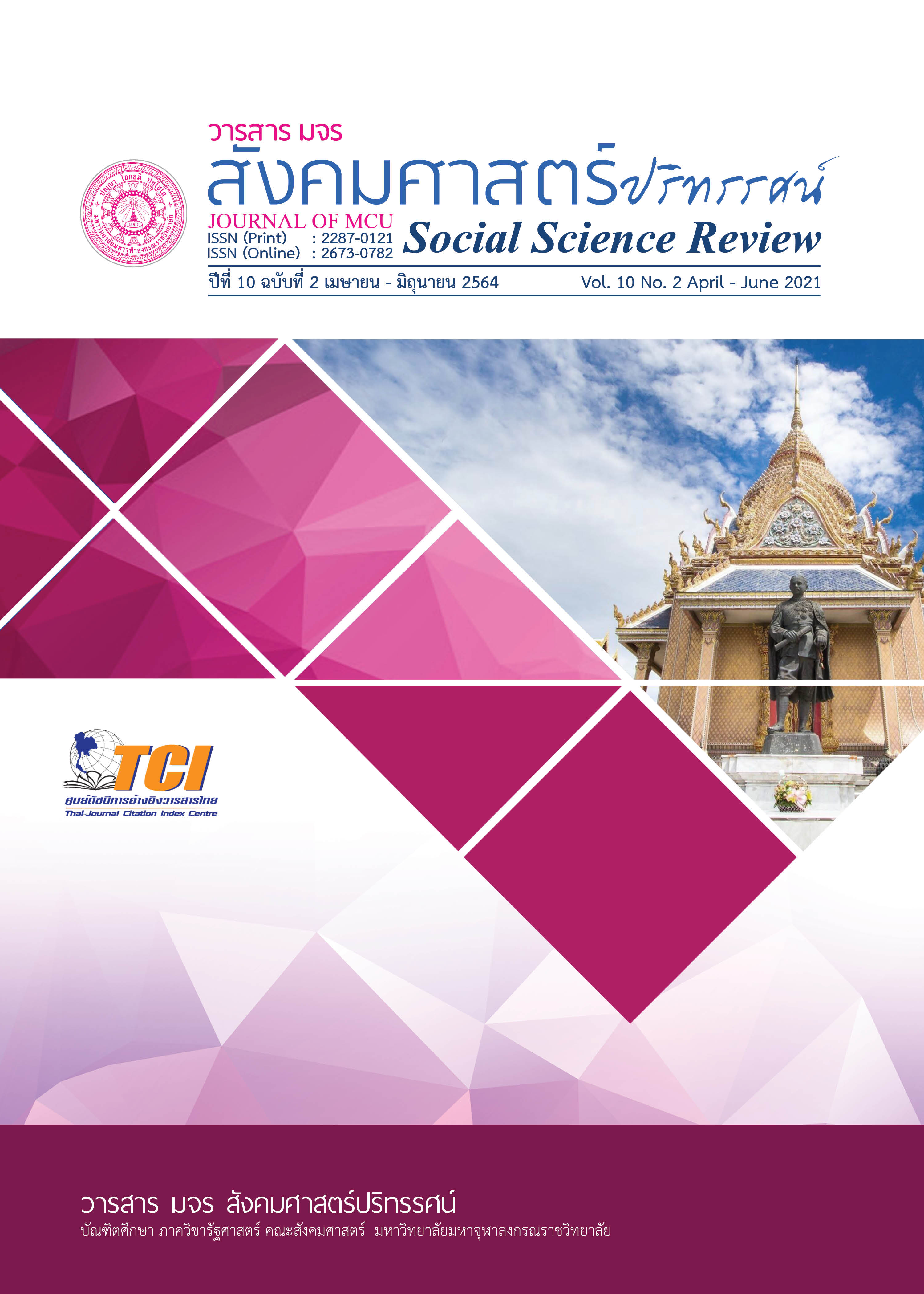แผนกลยุทธ์เพื่อพัฒนาการท่องเที่ยวแบบบูรณาการอย่างยั่งยืน ในจังหวัดศรีสะเกษ
คำสำคัญ:
แผนกลยุทธ์, การพัฒนา, การท่องเที่ยวยั่งยืน, จังหวัดศรีสะเกษบทคัดย่อ
การวิจัยครั้งนี้มีวัตถุประสงค์ เพื่อสร้างแผนกลยุทธ์ในการพัฒนาการท่องเที่ยวแบบบูรณาการอย่างยั่งยืนของจังหวัดศรีสะเกษ ใช้วิธีการวิจัยเชิงปริมาณ โดยสร้างแบบสอบถามการวิจัย ซึ่งเป็นข้อมูลที่ครอบคลุมในการสร้างแผนกลยุทธ์ในการพัฒนาการท่องเที่ยว และเก็บข้อมูลจากกลุ่มตัวอย่าง ได้แก่ ภาครัฐ ภาคเอกชน ประชาชน และนักท่องเที่ยว จำนวน 400 คน นำผลการวิเคราะห์ข้อมูลเชิงพรรณนา วิเคราะห์ด้วยการแจกแจงความถี่ และแสดงผลเป็น ค่าร้อยละ ค่าเฉลี่ย ค่าเบี่ยงเบนมาตรฐาน
ผลการวิจัยพบว่า ศรีสะเกษ มีทะเลหมอก ผามออีแดง น้ำตก ท่องเที่ยวสวนทุเรียนภูเขาไฟ ปราสาทหินสระกำแพงใหญ่ วัดศรีมงคลรัตนาราม วัดไพรพัฒนา งานเทศกาลดอกลำดวนบาน เทศกาลทุเรียนภูเขาไฟ งานประเพณี แซนโฎนตา เป็นทรัพยากรการท่องเที่ยวที่มีศักยภาพ และมีแผนกลยุทธ์ในการพัฒนาการท่องเที่ยว โดยมีวิสัยทัศน์ คือ สร้างแบรนด์ท่องเที่ยวเชิงนิเวศ “เมืองสีเขียวเล็ก ๆ ที่น่าอยู่บนที่ราบสูงโคราช เดินป่า กางเต็นท์ ดูดาว ดูนก ศึกษาระบบนิเวศในป่าเบญจพรรณ และป่าเต็งรังของอีสานล่าง สูดอากาศบริสุทธิ์ ชมวิวเทือกเขาพนมดงรัก บนผามออีแดง” มียุทธศาสตร์การพัฒนาการท่องเที่ยวศรีสะเกษ เพื่ออนุรักษ์สิ่งแวดล้อมอย่างยั่งยืนกลยุทธ์ และมีกลยุทธ์ด้านการใช้ประโยชน์พื้นที่ เพื่อพัฒนาแหล่งท่องเที่ยว และมีกลยุทธ์ด้านการจัดการทรัพยากร ทั้งนี้ กลยุทธ์ทั้งหมดมีความสัมพันธ์ต่อกัน และเมื่อมีการดำเนินการภายใต้กลยุทธ์แต่ละด้าน จะมีโครงการที่ต้องดำเนินการเพื่อให้บรรลุตามวัตถุประสงค์ ด้วยเหตุนี้ แผนกลยุทธ์เพื่อพัฒนาการท่องเที่ยวแบบบูรณาการอย่างยั่งยืน จึงให้ความสำคัญต่อสิ่งแวดล้อม สังคม เศรษฐกิจ วัฒนธรรมและการพัฒนาจิตใจ
เอกสารอ้างอิง
กระทรวงการท่องเที่ยวและกีฬา. (2560). แผนพัฒนาการท่องเที่ยวแห่งชาติฉบับที่ 2 พ.ศ.2560-2564. กรุงเทพฯ: กระทรวงการท่องเที่ยวและกีฬา.
เข้ม เล่งวิริยะกุล. (2560). แนวทางการพัฒนาคลัสเตอร์ท่องเที่ยวถนนชายโขง อำเภอเชียงคาน จังหวัดเลย. วารสารวิทยาลัยบัณฑิตศึกษาการจัดการ มข.,10(1), 220-246.
ดุสิตพร ฮกทา. (2562). ยุทธศาสตร์เพื่อการพัฒนาศักยภาพการท่องเที่ยวจังหวัดตรัง. วารสารปาริชาต มหาวิทยาลัยทักษิณ, 32(1), 215-247.
ธานินทร์ ศิลป์จารุ. (2548). การวิจัยและวิเคราะห์ข้อมูลทางสถิติด้วย SPSS (พิมพ์ครั้งที่ 4). กรุงเทพฯ: วี.อินเตอร์พริ้น.
ธีรวุฒิ เอกะกุล. (2543). ระเบียบวิธีวิจัยทางพฤติกรรมศาสตร์และสังคมศาสตร์. อุบลราชธานี: สถาบันราชภัฏอุบลราชธานี.
สุธาสินี วิยสภรณ. (2562). แนวทางการพัฒนาการจัดการการท่องเที่ยวอย่างยั่งยืน ชุมชนบางกระเจ้าอำเภอพระประแดง จังหวัดสมุทรปราการ. วารสารวิชาการสถาบันวิทยาการจัดการแปซิฟิค, 5(1), 115-123.
สำนักงานจังหวัดศรีสะเกษ. (2559). แผนพัฒนาจังหวัดศรีสะเกษ (พ.ศ.2561-2564). สืบค้น 14 เมษายน 2561, จาก http://www.sisaket.go.th/plan_si
World Travel & Tourism Council. (2019). Travel & Tourism: Global Economic Impact and Issues 2018. Retrieved April 14, 2019, from https://www.wttc.org/research/economic-research/economic-impactanalysis/#undefined
World Tourism Organization. (2011). Tourism Towards 2030 Global Overview. Spain: The World Tourism Organization.
ดาวน์โหลด
เผยแพร่แล้ว
รูปแบบการอ้างอิง
ฉบับ
ประเภทบทความ
สัญญาอนุญาต
ลิขสิทธิ์ (c) 2021 วารสาร มจร สังคมศาสตร์ปริทรรศน์

อนุญาตภายใต้เงื่อนไข Creative Commons Attribution-NonCommercial-NoDerivatives 4.0 International License.
เพื่อให้เป็นไปตามกฎหมายลิขสิทธิ์ ผู้นิพนธ์ทุกท่านต้องลงลายมือชื่อในแบบฟอร์มใบมอบลิขสิทธิ์บทความให้แก่วารสารฯ พร้อมกับบทความต้นฉบับที่ได้แก้ไขครั้งสุดท้าย นอกจากนี้ ผู้นิพนธ์ทุกท่านต้องยืนยันว่าบทความต้นฉบับที่ส่งมาตีพิมพ์นั้น ได้ส่งมาตีพิมพ์เฉพาะในวารสาร มจร สังคมศาสตร์ปริทรรศน์ เพียงแห่งเดียวเท่านั้น หากมีการใช้ภาพหรือตารางหรือเนื้อหาอื่นๆ ของผู้นิพนธ์อื่นที่ปรากฏในสิ่งตีพิมพ์อื่นมาแล้ว ผู้นิพนธ์ต้องขออนุญาตเจ้าของลิขสิทธิ์ก่อน พร้อมทั้งแสดงหนังสือที่ได้รับการยินยอมต่อบรรณาธิการ ก่อนที่บทความจะได้รับการตีพิมพ์ หากไม่เป็นไปตามข้อกำหนดเบื้องต้น ทางวารสารจะถอดบทความของท่านออกโดยไม่มีข้อยกเว้นใดๆ ทั้งสิ้น





